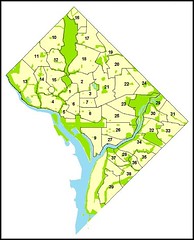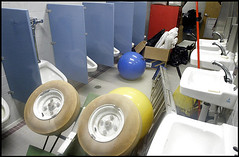Provision of public services and recreational centers
Is something that I have had some important realizations about that have shaped my understanding about the need to build more robust planning processes.
For a few years I have been writing about municipal facilities planning, and the need to have a more coordinated process. (Often this is called co-location, where facilities and programs of at least two agencies are delivered in one place.)
For the most part, DC has separated facilities.
And for the most part, DC's separated facilities are the same everywhere.
One of my realizations is that cities like DC need to plan for programs and facilities on at least 3 levels:
1. City-wide;
2. Sub-city districts (in DC, you could do this by quadrants, the city has four, or by Wards, the city has eight, although the boundaries change after each Census, by "Cluster, the city has defined 39, or by "Areas," in the most recent Comprehensive Plan, 10 areas with fixed boundaries were defined, and replaced ward-based sub-plans); and
3. Neighborhoods
This doesn't necessarily mean plans for every cluster, although under the Williams Administration, budget planning was supposed to be defined at that level and one of the first steps of the Williams Administration in 2001 was for each cluster to do a plan.
I thought that the process was constrained, that by planning through the lens of DC government agencies and how they spent money, without being able to have much influence on those agencies, and without taking the time to state what mattered most, and without inventorying the various civic assets within "clusters" as part of these plans, that a lot was missed.

DC's 39 clusters. I think this process may be being abandoned. Plans, or "documents," because most weren't really "plans" the way I would define a plan, were released in 2002 and haven't been updated.
While for a different purpose, the way that the West End Visioning Process I worked on with the Foggy Bottom Association, the Dupont Circle Citizens Association, and the local ANCs there, was designed to look more carefully at the set of public assets within a community, and work towards a shared consensus and planning method that addressed the issues around these facilities in a coordinated and complementary fashion.
The Post had a story on DC recreation centers yesterday, "Recreation Funds Flow Freely in D.C.: Fenty Promotes New Pools and Playgrounds, but Can City Afford Them?."
The article doesn't say much that isn't already in the headline.
I have blogged about this issue a fair amount, in "Prototyping and municipal capital improvement programs,"Dispuptive innovation (once again)," "Chauvinism, mediocrity and robust systems," and "Social Marketing the Arlington (and Tower Hamlets and Baltimore) way," and "Another take on municipal capital improvement planning."
These paragraphs from the last entry summarize my argument:
I commented how under the Williams Administration, DC entered into a massive rehabilitation and expansion of recreation centers, but that the program of offerings was never really evaluated, meaning that each center is the same, and an evaluation of the recreation centers comprehensively as a set of offerings on a city-wide and sub-city "regional" basis wasn't performed, so needed facilities on a city-wide basis (i.e., indoor track, exposition center, etc.) were neither considered nor built, so a lot of money was spent but while better facilities were achieved, a significantly improved array of recreation programs weren't obtained.
(The Fenty Administration is doing the same thing.)
Seeing this article from the Boston Globe, albeit about a private facility, the YMCA in Marblehead, Massachusetts, makes me think about these examples again. See "New YMCA dazzles and delights with bells, whistles, and ballet." The new YMCA has a climbing wall, a wi-fi cafe, and ballet studios, among other facilities--making the point again about the need for expansive consideration when embarking on the construction of municipal facilities that serve the public directly.
Most capital improvement projects are generational--designed to last at least 30 years without significant change. So having the right planning process upfront is crucial to doing it right.
It's a shame that we spend so much money on facilities such as libraries, schools, recreation centers, and senior wellness centers, and don't achieve nearly what could be achieved, if we had more expansive and visionary thinking about what these facilities could accomplish for both the neighborhoods and the city as a whole.
------
DC doesn't have a public waterpark, it doesn't have any public indoor tracks, or relatively low cost "exposition" facilities. Facilities to support artists are limited. Etc.
It has senior wellness centers separate from public recreation centers, even though the former buildings are most likely used during the day, and rec centers experience the greatest amount of use in the late afternoon and evening.
If first we set citywide goals of what we want--e.g., one waterpark, 2-3 indoor tracks, heated outdoor pools (see "D.C. Installs City's First Pool Heater at East Potomac Facility" from the Post), various artist and continuing education facilities, exposition type space (right now only the DC Armory or the Convention Center have this kind of space, and it is mostly out of the price range of community and civic organizations) based on our population and the number of facilities required to meet community needs--such programs and facilities could be provided, distributed across the city, but located within "neighborhood" recreation centers that serve DC residents more generally as well as neighborhood residents.
Collectively residents would be offered a wide array of facilities and programs, maybe not necessarily within their neighborhoods only, but within a reasonable distance from where they live--DC isn't that big after all.
That to me is one of the most damning aspects of DC Government, what agencies do and how they plan, and planning generally.
The city, by failing to plan and creatively use the plenitude of resources at its disposal, offers less to its residents than the nearby counties. Even Arlington, which is about 1/3 the size and population of DC, offers its residents more.
To me, this was a major failing of yesterday's Post article, which failed to compare to DC to the surrounding jurisdictions, and to look more carefully at how the planning is conducted.
And yes, it is a travesty that Mayor Fenty's name is pasted over a soccer field ("Mayor Unveils 'Fenty Field'" from the Post). Maybe we could start imprinting the names of elected officials in park grass cutting too.
It totally blows the opportunity of "diversity" (and compactness) that Jane Jacobs discusses in Death and Life of Great American Cities, where she writes:
To understand cities, we have to deal outright with combinations or mixtures of uses, not separate uses, as the essential phenomena. We have already seen the importance of this in the case of neighborhood parks. Parks can easily--to easily--be thought of as phenomena in their own right and described as adequate or inadequate in terms, say, of acreage rations to thousands of population. Such an approach tells us something about the methods of planners, but it tells us nothing useful about the behavior or value of neighborhood parks.
A mixture of uses, if it is to be sufficiently complex to sustain city safety, public contact and cross-use, needs an enormous diversity of ingredients. So the first question--and I think by far the most important question--about planning cities is this: How can cities generate enough mixtures among uses--enough diversity--throughout enough of their territories, to sustain their own civilization. (p. 144)
--------------
Speaking of not prototyping nor learning from mistakes
From email:
The Department of Parks and Recreation invites you to the North Michigan Park Community Meeting
Friday, February 11, 2008
6:30pm - 8:30pm
North Michigan Park Community Center
1333 Emerson Street, NE
This meeting will discuss the re-design of excessive bathroom space at North Michigan Park Community Center.
For more information, please contact Jackie Stanley, at 202-671-0420.
Image from the Washington Post article from 2006, "DC Recreation Center Rich With Restrooms."




0 Comments:
Post a Comment
<< Home